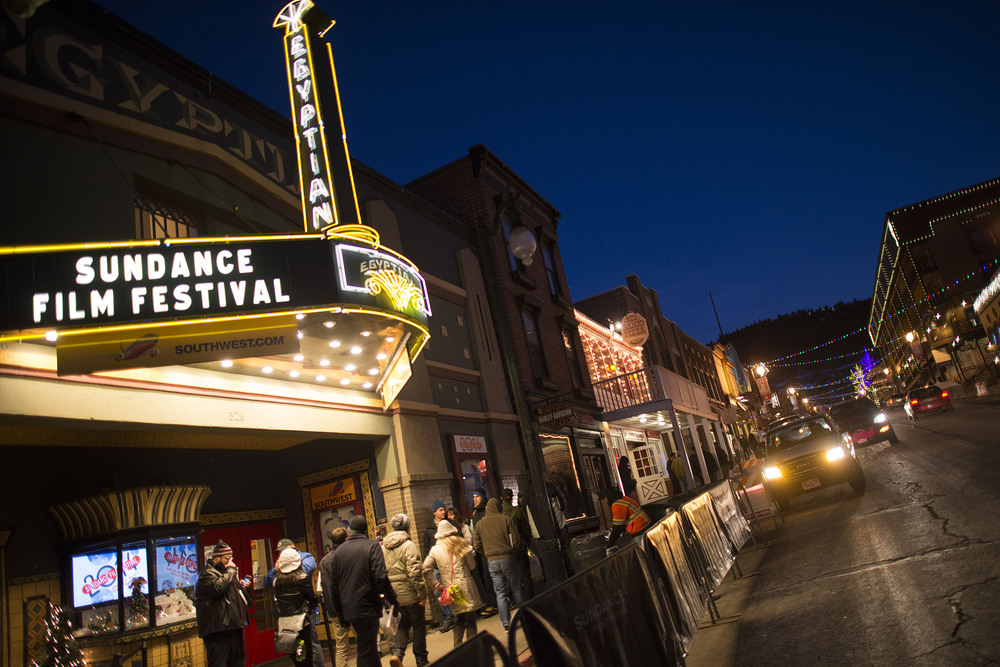Sundance is a festival I love and have attended over 20 times, so I thought I’d share some insight on Film Festival Strategies. Now every festival – big and small – has its DNA, and the cinematic fabric they possess makes them original, “must-attend” events. So, instead of sharing a snowdrift full of Sundance insight, I wanted to give you some general strategies that apply to all film festivals. In doing so, I’d like to start by sharing one of my most magical film festival experiences: The Dawson City International Short Film Festival.

I was gazing at this stuffed bear in a glass case at the airport in Fairbanks, Alaska, when the first eerie, “what the hell am I getting myself into” feeling arrested me. The bear wasn’t a cute little stuffed animal – he was very big and dead and was the proudest example of taxidermy that Fairbanks had to offer. My filmmaker buddy Steve Nelson and I were only in Fairbanks because we were en route to the Dawson City International Short Film Festival in Dawson City, Yukon. That’s right, the Canadian Yukon – incredibly damn north from everything and just south of the Arctic Circle. All I knew about Dawson City was it had been a thriving Gold Rush town, and Steve and I were staying at a hip B&B called “Bombay Peggy’s,” which used to be a brothel. Side Note: Owen Wilson, Steve Martin, and Jack Black stayed at Bombay Peggy’s while shooting David Frankel’s film, “The Big Year.” So, as I bid farewell to “Mr. Bear” and boarded our plane, which was no larger than a Dodge minivan – I almost went into cardiac arrest when I realized our flight attendant was also our co-pilot! But, my fear quickly melted in sheer fascination as we flew over some of the most breathtaking unbridled wilderness on the planet.

Steve and I were smitten when we landed in Dawson City. Nestled at the edge of the Yukon River and the Klondike River, this perfectly timeless location for a film festival sported gravel roads, no streetlights, and no cell phone service. In short, Dawson was a slice of Heaven itself, and “Heaven” was graced by some of the most fiercely creative and wonderfully eclectic people I’d ever met.
The festival director David is a gem of a guy who had his beloved dog sled him to work during the winter months. Wendy, the owner of “Bombay Peggy’s,” was a treasure; John, an artist turned Webmaster turned Mayor of Dawson City, and John the Vet, the town veterinarian turned animator, were some of the town’s golden nuggets. I even befriended “Caveman Bill,” another fine artist living in a cave (I’m serious). Throughout the weekend, I realized that The Dawson City International Short Film Festival is exactly what all festivals should become or strive to become again: a place to celebrate films and filmmakers without the politics of trying to get a sale.
In addition to having experienced film festival bliss from way up in the Great White Canadian North, I’ve attended over 200 film festivals and have had the honor to be a judge, screener, or panelist at several of them, including Sundance, SXSW, Slamdance, Flickerfest (in Sydney), Nashville (NaFF), to name a few. I also founded the Lonely Seal International Film, Screenplay, and Music Festival, a Top 100 Best Reviewed festival, but I’ll do another article about my cinematic baby soon. Anyway, I have picked up a few trends about film festivals that may be helpful, so here are eleven key Film Festival Strategies:
1) Submit A Completed Film – Not A Rough Cut
Filmmakers should refrain from applying with a rough cut or an otherwise incomplete film because your first impression is your first impression. Trying to get noticed off a rough cut would be like me back in my dating days, showing up on a blind date with my 5’4”, rail thin, and somewhat disabled body, telling my date, “Hi, I wanted to meet you right away, but don’t judge me for what you see. Give me a few months to make myself look better, and I’ll come back a foot taller, far more buff and able-bodied.” That tactic would never work in dating, nor does it work while applying to a film festival. Remember, film festival programmers can only see what they can see.

2) Shorter Is ALWAYS Better
Of course, I believe “shorter is better” because I’m short. But, about films, this trend applies to both shorts and features.
Shorts – Keep the total running time in single digits because the shorter your film is, the easier it is for the programmer to find a slot. This is because most screening slots are two hours long, including an intro and a Q&A session. So, a “long” short will miss out on several festivals that may have liked the film but couldn’t find a slot. The other reason for keeping it short is that distributors, executives, or agents can review it between meetings or over coffee. Conversely, a long short film may sit on their desk for eternity because watching something too long is daunting.
Features – Keep your film between eighty-five and ninety-five minutes long, especially if your film isn’t laced with well-known actors. As a screener for Sundance in 2005, I saw seventy-eight features in five weeks. When all you’re doing for over a month is watching movies from morning till moonlight, there’s a noticeable difference between watching a very good ninety-minute film and a drawn-out two-hour film that could have been a very good ninety-minute film.

3) Avoid Overly Used Student Film Markers
Most student films are littered with drugs, weapons, nudity, and foul language. While I love these elements when they enhance the fabric of the story, like in “Scarface” (1983) and “Raging Bull” (1980), several indies use them so incessantly that their film gets lost in the mix with thousands of other films just like it. I’ve always believed that doing something fresh and different is far more potent than using a potent weapon. Besides, most Oscar-winning shorts tend to be fresh and quirky with impressive poignancy or cinematic accomplishment.

4) It’s Where You Start, Not Where You Finish
Unlike most life cases when your finish is more important than your start, the perceived value of your film on the festival circuit is based on the first one that accepts you. Thus, having your “World Premiere” at Cannes, Berlin, Sundance, Toronto, SXSW, or Tribeca is a dream. Subsequently, premiering at a small festival before you find out if any of the larger ones want you may turn into a nightmare because you will be disqualified from larger festivals for playing a smaller one first.
5) Be Careful Not To Play Too Many Festivals
Do you know what a distributor thinks when an indie filmmaker says their film played thirty-eight festivals? He or she immediately realizes that since the film has already played in so many cities for free, most of the people the distributor wanted to sell the film to have already seen it.

6) Hide Your Treasure Before Your Premiere
Never show anyone a copy of your film before its Worldwide Premiere – unless a buyer/distributor is willing to buy it before it premieres.
7) Don’t Hold Back Links of Your Films From Distributors
After your World Premiere, show distributors your film. Most distributors can’t make screenings, and it’s easier for them to watch it on DVD anyway. Don’t worry; if your film is solid on the silver screen, it should hold up on the tube.
8) Wine Is More Expensive Aged, But Films Aren’t
If the goal is to get your film distributed, you should think twice about going on a full-fledged, year-long festival tour because all you’re doing is making your film older and worth less money. Just play some key festivals, then get your baby sold while it’s still perceived as being new and fresh. If your film fails to get distribution, play as many festivals as your heart desires.

9) Construct A Great Viral Campaign
Make your website and internet campaign hip and memorable by giving festival programmers and distributors a reason to visit it more than once. Just ensure you don’t upload your actual film on the internet because doing so may quickly disqualify you from many festivals.

10) Get Film Festivals Engaged Early On
First, research what film festivals best suit the tone and genre of your film, and then contact them early on in your filming process. If you can engage them in your film, you may have a better shot at getting into their festival. Of course, your final product matters, but a healthy relationship with a festival can often tilt the chances of a “yes” in your favor.

11) Don’t Burn Bridges With Festivals
There are quite a few reasons why festivals may pass on your film. They either didn’t like it, they liked it, but it didn’t fit into a time slot, or it didn’t fit into their program’s theme, to name a few. Either way, do not call festivals that rejected your film and give them a screaming piece of your mind. Always remember, not only do festival programmers have feelings, but they also have impeccable memory capabilities. Much like a teenager getting a driver’s license, getting accepted by a film festival is a privilege, not a right. Filmmakers should embrace film festivals as such (a privilege) because they may be your film’s best platform to capture an audience.
Okay, that’s what I have today. Before I go, here’s a link to a cool video from “Film Riot” about “How to Get Into a Film Festival.”
Furthermore, my podcast, Limping On Cloud 9, is positivity-infused so that it may serve as a short getaway from the pile of work you’re staring at at this very moment. My podcast is available on iTunes, Google Play and Stitcher. Here is our website:
https://limpingoncloud9.com/how-an-armless-disabled-child-changed-my-life/
I’ve also linked a slide show on “Film Festivals Around The World” by Maps of the World. I thank you for lending me your eyes.

